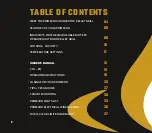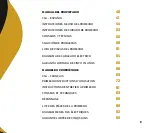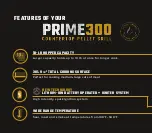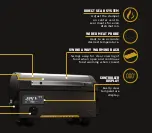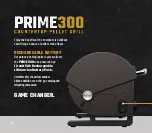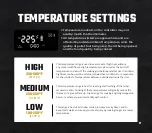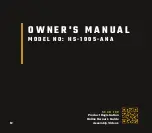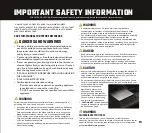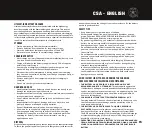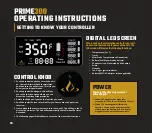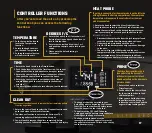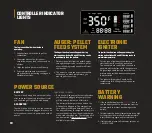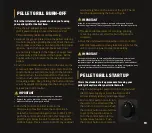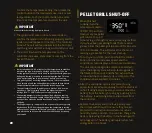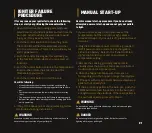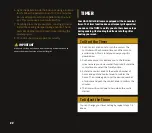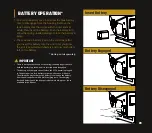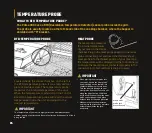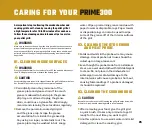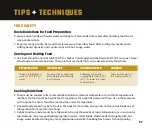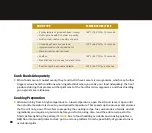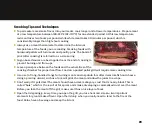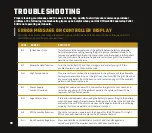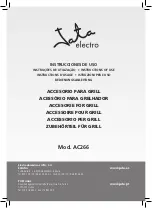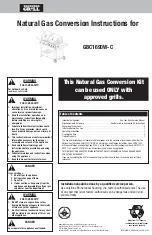
15
CSA - ENGLISH
Lithium-ion battery fire hazards are associated with the high energy
densities coupled with the flammable organic electrolyte. This creates
new challenges for use, storage, and handling. Studies have shown that
physical damage, electrical abuse such as short circuits and overcharging,
and exposures to elevated temperature can cause a thermal runaway. This
refers to rapid self-heating from an exothermic chemical reaction that can
result in a chain reaction thermal runaway of adjacent cells.
LITHIUM-ION BATTERY HAZARDS
• Store batteries away from combustible materials.
• Remove batteries from the device for long-term storage.
• Store the batteries at temperatures between 41°F and 68°F.
• If practical, store batteries in a metal storage cabinets.
STORAGE
• Never charge a primary (disposable lithium or alkaline) battery; store
one-time use batteries separately.
• Charge or discharge the battery to approximately 50% of capacity
before long-term storage.
• Use chargers or charging methods designed to charge in a safe
manner battery packs at the specified parameters.
• Disconnect batteries immediately if, during operation or charging,
they emit an unusual smell, develop heat, change shape/geometry, or
behave abnormally.
• Remove battery pack from chargers promptly after charging is
complete.
• Do not use the charger as a storage location.
CHARGING PRACTICE
• Handle batteries and or battery-powered devices cautiously to not
damage the battery casing or connections.
• Keep batteries from contacting conductive materials, water, seawater,
strong oxidizers and strong acids.
• Do not place batteries in direct sunlight, on hot surfaces or in hot
locations.
• Inspect batteries for signs of damage before use. Never use and
promptly dispose of damaged or puffy batteries.
•
Keep all flammable materials away from operating area.
• Allow time for cooling before charging a battery that is still warm
from usage and using a battery that is still warm from charging.
• Consider cell casing construction (soft with vents) and protective
shielding for battery research and experimental or evolving
application and use.
HANDLING AND USE
Dispose of damaged battery pack that no longer hold a substantial charge.
To check the general condition of your cells, charge them, let them rest for
DISPOSAL
• Keep battery out of sight and reach of children.
• Rechargeable Lithium-ion pack is potentially hazardous and can
present a serious FIRE HAZARD, SERIOUS INJURY and/or PROPERTY
DAMAGE if damaged, defective or improperly used.
• By purchasing the battery, you assume all risks associated with the
battery. We are not responsible for any damages and consequential
damages by using our products. Use at your own risk.
• Do not disassemble or modify the battery on any way. Vibration,
puncture, contact with metals, or tampering with the battery can
cause it to fail.
• Do not disassemble or modify the battery on any way. Vibration,
puncture, contact with metals, or tampering with the battery can
cause it to fail.
• Never leave the battery unattended while charging. If the battery
becomes hot, smokes, swells, or gives off an odor during charging,
terminate charging immediately.
•
In the event the battery leaks and the fluid gets onto your skin or
into your eyes do not rub. Rinse well with water and immediately
seek medical care. If left untreated, the battery fluid could cause
damage to the eye and skin.
SAFETY TIPS
• THE BATTERY HAS BEEN FULLY DISCHARGED AND IS NOT
RECHARGED SHORTLY AFTERWARD.
This potential is aggravated
if batteries are damaged, contain an undetected factory defect, are
used or stored at temperature extremes, or are approaching the end
of their useful life. Ideally, battery should be recharged within 24
hours of a full discharge.
• CHARGING IS ATTEMPTED AT TEMPERATURES BELOW 40°F.
Charging below 40°F causes a chemical reaction in the battery cells
that can cause permanent damage and the possibility of fire or
explosion during charging.
• THE BATTERY HAS BEEN EXPOSED TO LIQUIDS, ESPECIALLY
SALT WATER.
Exposure to liquids can cause internal corrosion or
damage to the cells or to the Battery Management System (BMS).
The BMS protects the battery from overcharging, high self-discharge
or imbalanced charging of the cells, any of which can present the
possibility of fire during recharging.
• OPERATING OR CHARGING A BATTERY THAT HAS BEEN DAMAGED
FROM DROPPING OR FROM SHIPPING DAMAGE. USING A CHARGER
OTHER THAN SPECIFICALLY DESIGNATED FOR THE PARTICULAR
BATTERY.
A FIRE IS MOST LIKELY TO OCCUR DURING THE CHARGING
PROCESS UNDER THE FOLLOWING CIRCUMSTANCES
an hour, then measure the voltage. If your cells are close to 12V, the battery
pack is in good condition.
Summary of Contents for PRIME300 HS-1005-ANA
Page 1: ...1 ESSENTIALS GUIDE...
Page 5: ...5...
Page 33: ...33 PARTS LIST...
Page 36: ...36 ELECTRICAL WIRE DIAGRAM...
Page 61: ...61 LISTA DE PIEZAS DEL...
Page 64: ...64 DIAGRAMA DE CABLEADO EL CTRICO...
Page 89: ...89 LISTE DES PI CES DU...


